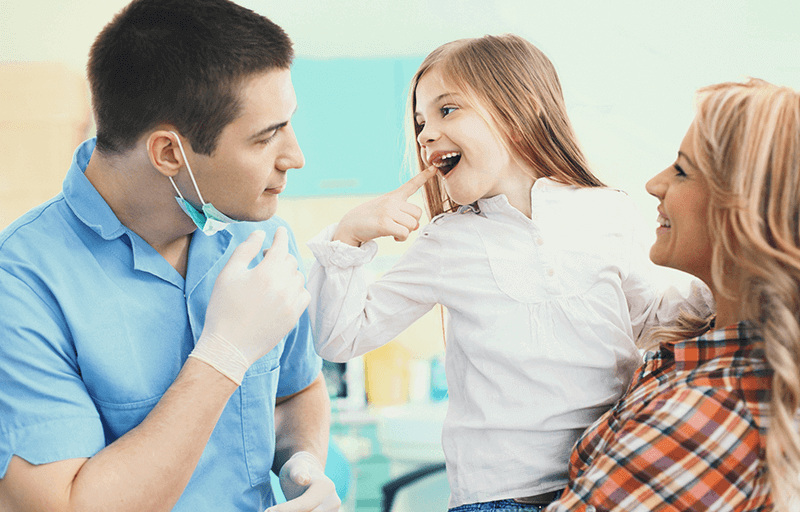Cavities are the most common chronic childhood disease in the country. And dental problems in childhood often lead to continued dental issues as an adult.
Fortunately, the opposite is also true. When kids learn how to properly care for their teeth at a young age, they’re more likely to enjoy a lifetime of great oral health. Here’s an in-depth guide on how to help maintain proper oral hygiene for your kids, from birth to braces and beyond.
Starting Early: Newborn Dental Care
Dental care actually starts before the first tooth ever appears. Use a soft, wet washcloth to gently wipe your baby’s gums in the morning, before bed and after each feeding. Only use water on the washcloth – avoid toothpaste or any other cleanser unless recommended by your dentist.
Simple but effective, wiping the gums helps prevent plaque buildup. While plaque is normally associated with tooth decay, this soft and sticky bacteria buildup can also damage gums. Regular cleaning helps keep the gums clean, healthy and ready for teeth to appear.
After the First Tooth Appears
A baby’s first tooth is a fun and exciting milestone. It’s also a signal to start two important aspects of dental care:
- The first dental visit can be scheduled
- Daily tooth brushing can begin
The general rule is your child should see a dentist either soon after their first tooth emerges or before their first birthday, whichever is first. The first tooth can emerge as early as four months, but it more commonly appears between six months and a year.
Even the eruption of just one tooth means regular tooth brushing should begin. Choose a toothbrush made for kids. They’ll have soft bristles and a cushioned head. Parents should brush their child’s teeth twice a day for two to three minutes each time.
For babies and toddlers, only use non-fluoridated toothpaste. Fluoride is an important mineral used to prevent tooth decay but can be harmful if too much is swallowed. Non-fluoridated toothpaste is recommended until the child is old enough not to swallow toothpaste when brushing, which usually happens around the age of two. Only a pea-sized dab is necessary when brushing (and that actually goes for adults, too.)
Staring around the age of two, most kids will be able to use the toothbrush on their own – at least somewhat. Of course, brushing will still be a bit complicated and cumbersome for little hands. Parents will want to supervise and assist as necessary. Usually, children won’t have the manual dexterity to completely brush on their own until the age of seven.
Proper Care for Primary and Permanent Teeth
After the first tooth erupts, others are sure to follow. Around the age of three, your child should have a full set of 20 primary teeth. Also called baby teeth, primary teeth have less enamel than permanent teeth, making them more susceptible to cavities.
Primary teeth aren’t designed to last. But they still need to be properly protected against cavities, accidents and other dental damage. Primary tooth problems can directly affect the health and positioning of permanent teeth. Children will have a mixture of primary and permanent teeth between the ages of about six to 12.
How to Make Brushing Fun for Kids
If dental care is fun, kids are more likely to take care of their teeth each day. Kids (and adults) should brush for at least two minutes each time. Two minutes can seem like an eternity, especially to a younger child, so you’ll probably want to use a timer.
Timers are included on a wide variety of children’s toothbrushes. Kids brush their teeth while listening to a fun song. Aside from a timer on a toothbrush, different apps are available which also perform the same function.
Toys are also a great way to help younger kids learn basic brushing techniques. Special stuffed animals, dolls and other toys include teeth which kids can pretend to brush using toy toothbrushes. This brushing practice helps kids understand where in the mouth their own teeth are located. Additionally, kids often learn brushing techniques by watching their parents brush. You can even let your children brush your own teeth.
Finding the Right Dental Partner
Children are usually best served by a pediatric dentist. Pediatric dentistry is one of nine dental specialties officially recognized by the American Dental Association. Pediatric dentists have extensive knowledge of the unique needs of primary teeth, permanent teeth and the transition period between the two.
Plus, pediatric dentists and their entire staff are also able to create a comfortable environment for children. The office will be child-sized and child-friendly. A pediatric dentist is able to keep kids at ease while also teaching them proper oral care techniques.
Try to stay with the same pediatric dentist as long as possible. When a dentist is able to examine your child’s oral health consistently over many years, they’ll have a better understanding of how teeth are developing. This can be especially important to ensure both permanent and wisdom teeth emerge properly.
Saving Money on Oral Health Care
A lifetime with no or minimal dental problems is invaluable. But actual costs for children’s dental care can quickly add up. Fortunately, dental savings plans can help make dental care more affordable for the entire family. Dental savings plans offer discounts of 10% to 60% at over 100,000 dental offices across the country, including a variety of pediatric dentists.
Dental savings plans have no annual limits of use. While specifics vary, dental savings plans can often provide instant savings on routine procedures such as checkups and cleanings as well more extensive procedures such as cavity treatments, root canals, wisdom tooth removal and orthodontic work.
Developing a plan for childhood dental care, along with using a dental savings plan to help make dental visits more affordable, is the best way to ensure your child has a healthy smile for life!


